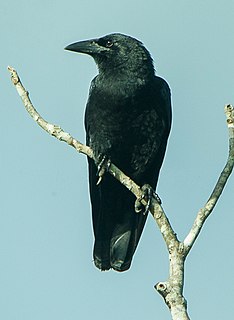 W
WThe Greater Antillean bullfinch is a species of bird in the family Thraupidae. It is found in the Bahamas, the Dominican Republic, Haiti, Jamaica, and the Turks and Caicos Islands. Its natural habitats are subtropical or tropical dry forest, subtropical or tropical moist lowland forest, subtropical or tropical moist montane forest, subtropical or tropical dry shrubland, and heavily degraded former forest.
 W
WThe Cuban crow is one of four species of crow that occur on a few key islands in the Caribbean. It is closely related to the white-necked crow and Jamaican crow, with which it shares similar features. The fourth Caribbean crow, the palm crow, is a later arrival in evolutionary terms and shows characteristics more akin to North American species such as the fish crow, which it is probably closely related to.
 W
WThe American flamingo is a large species of flamingo closely related to the greater flamingo and Chilean flamingo. It was formerly considered conspecific with the greater flamingo, but that treatment is now widely viewed as incorrect due to a lack of evidence. It is also known as the Caribbean flamingo, although it is also present in the Galápagos Islands. It is the only flamingo that naturally inhabits North America.
 W
WThe Bahama mockingbird is a species of bird in the family Mimidae. It is found in the Bahamas, Cuba, Jamaica and the Turks and Caicos Islands, and is a vagrant to Florida. Its natural habitats are subtropical or tropical dry forest, subtropical or tropical moist lowland forest, subtropical or tropical dry shrubland, and heavily degraded former forest.
 W
WThe redhead is a medium-sized diving duck. The scientific name is derived from Greek aithuia an unidentified seabird mentioned by authors including Hesychius and Aristotle, and Latin americana, of America. The redhead is 37 cm (15 in) long with an 84 cm (33 in) wingspan. Redhead weight ranges from 2.0-2.5 lbs, with males weighing an average of 2.4 lbs and females weighing an average of 2.1 lbs. It belongs to the genus Aythya, together with 11 other described species. The redhead and the common pochard form a sister group which together is sister to the canvasback.
 W
WThe Bahama swallow is a swallow found only in the Bahamas.
 W
WThe pearly-eyed thrasher is a bird in the thrasher family Mimidae. It is found on many Caribbean islands, from the Bahamas in the north to the Grenadines in the south, with an isolated population on Bonaire. At least two subspecies can be distinguished genetically: Margarops fuscatus fuscatus which is found between the Greater Antilles and Antigua and Barbuda, M. f. densirostris, occurring from Montserrat and Guadeloupe southwards. Its main habitat is bushes and trees in mountain forests and coffee plantations.
 W
WThe thick-billed vireo is a small songbird. It breeds in the West Indies in the Bahamas, Turks and Caicos Islands, Cayman Islands, Tortuga Island in Haiti and on cays off the coast of Cuba. It occasionally can be found as a vagrant to south Florida in the United States. The subspecies V. c. approximans of Providencia Island is sometimes treated as a subspecies of the mangrove vireo or as a separate species, the Providencia vireo.
 W
WThe Bahama woodstar is a species of hummingbird endemic to the Bahama archipelago, including the Bahama and Turks and Caicos islands. It is named the "Hummer" by locals due to a distinct humming sound it makes while feeding.